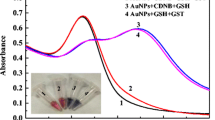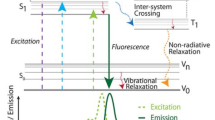Abstract
Fluorescence resonance energy transfer (FRET) is a kind of energy transfer mechanism depending on the distance between donor and acceptor, which exhibited potential application in biosensors. In this study, an efficient fluorescence “turn-on” strategy for the detection of glutathione (GSH) has been established based on FRET between nitrogen and sulfur dual-doped carbon dots (N,S-CDs) and gold nanoparticles (Au NPs). A novel N,S-CDs was synthesized by a one-pot hydrothermal treatment of 3-aminothiophenol, which possessed excellent fluorescence property with the maximum emission wavelength of 530 nm. Then, the as-prepared N,S-CDs served as energy donor to transfer energy to Au NPs via FRET process, resulting in fluorescence quenching of N,S-CDs. However, the fluorescence of N,S-CDs was recovered efficiently by adding GSH into the mixture solution of N,S-CDs and Au NPs. Therefore, the FRET assembly of N,S-CDs and Au NPs was used as a fluorescence probe for the “turn-on” sensing GSH with the linear range from 3.8 to 415.1 μM and the limit detection of 0.21 μM. This nanosensor platform was employed to monitor GSH in serum samples with satisfying results.

Graphical abstract








Similar content being viewed by others
References
Singh VK, Yadav PK, et al. Peroxidase mimetic activity of fluorescent N,S-carbon quantum dots and their application in colorimetric detection of H2O2 and glutathione in human blood serum. J Mater Chem B. 2018;6:5256–68.
Gao Y, Wu KL, Li HY, Chen W, Fu M, Yue K, et al. Glutathione detection based on peroxidase-like activity of Co3O4-montmorillonite nanocomposites. Sensors Actuators B Chem. 2018;273:1635–9.
Wu R, Ge HG, Liu CF, Zhang SH, Hao L, Zhang Q, et al. A novel thermometer-type hydrogel senor for glutathione detection. Talanta. 2019;196:191–6.
Peng HP, Jian ML, Huang ZN, Wang WJ, Deng HH, Wu WH, et al. Facile electrochemiluminescence sensing platform based on high-quantum yield gold nanocluster probe for ultrasensitive glutathione detection. Biosens Bioelectron. 2018;105:71–6.
Chen W, Zhao Y, Seefeldt T, Guan X. Determination of thiols and disulfides via HPLC quantification of 5-thio-2-nitrobenzoic acid. J Pharm Biomed. 2008;48:1375–80.
Saha A, Jana NR. Detection of cellular glutathione and oxidized glutathione using magnetic-plasmonic nanocomposite based turn-off surface enhanced Raman scattering. Anal Chem. 2013;85:9221–8.
Chen LY, Jong SP, Wu D, Cheol HK, Yoon JY. A colorimetric and fluorescent probe for rapid detection of glutathione and its application to tissue specific bioimaging in living cells and zebrafish. Sensors Actuators B Chem. 2018;262:306–12.
Burford N, Eelman MD, Mahony DE, Morash M. Definitive identification of cysteine and glutathione complexes of bismuth by mass spectrometry: assessing the biochemical fate of bismuth pharmaceutical agents. Chem Commun. 2003;14:146–7.
Hodáková J, Preisler J, Foret F, Kubán P. Sensitive determination of glutathione in biological samples by capillary electrophoresis with green (515 nm) laser-induced fluorescence detection. J Chromatogr A. 2015;1391:102–8.
Wawegama NK, Browning GF, Kanci A, Marenda MS, Markham PF. Development of a recombinant protein-based enzyme-linked immunosorbent assay for diagnosis of Mycoplasma bovis infection in cattle. Clin Vaccine Immunol. 2014;21:196–202.
Chen W, Wu XD, Pu L. Highly selective fluorescent recognition of glutathione by using a water soluble binaphthyl aldehyde. Tetrahedron Lett. 2017;58:1781–3.
Qin J, Zhang LM, Yang R. Powder carbonization to synthesize novel carbon dots derived from uricacid for the detection of Ag(I) and glutathione. Spectrochim Acta A Mol Biomol Spectrosc. 2019;207:54–60.
Niu LY, Guan YS, Chen YZ, Tung CH, Yang QZ. BODIPY-based ratiometric fluorescent sensor for highly selective detection of glutathione over cysteine and homocysteine. J Am Chem Soc. 2012;134:18928–31.
Shao N, Jin J, Wang H, Zheng J, Yang R, Chan W, et al. Design of bis-spiropyran ligands as dipolar molecule receptors and application to in vivo glutathione fluorescent probes. J Am Chem Soc. 2010;132:725–36.
Yang CL, Deng WP, Liu HY, Ge SG, Yan M. Turn-on fluorescence sensor for glutathione in aqueous solutions using carbon dots–MnO2 nanocomposites. Sensors Actuators B Chem. 2015;216:286–92.
Cai QY, Li J, Ge J, Zhang L, Hu YL, Li ZH, et al. A rapid fluorescence “switch-on” assay for glutathione detection by using carbon dots-MnO2 nanocomposites. Biosens Bioelectron. 2015;72:31–6.
Xiang HJ, Tham HP, Nguyen MD, Phua SZF, Lim WQ, Liu JG, et al. An aza-BODIPY based near-infrared fluorescent probe for sensitive discirmination of cysteine/homocysteine and glutathione in living cells. Chem Commun. 2017;53:5220–3.
Deng JH, Lu QJ, Hou YX, Liu ML, Li HT, Zhang YY, et al. Nanosensor composed of nitrogen-doped carbon dots and gold nanoparticles for highly selective detection of cysteine with multiple signals. Anal Chem. 2015;87:2195–203.
Zhang Q, Gong Y, Guo XJ, Zhang P, Ding CF. Multifunctional gold nanoparticle-based fluorescence resonance energy-transfer probe for target drug delivery and cell fluorescence imaging. ACS Appl Mater Interfaces. 2018;10:34840–8.
Han X, Han M, Ma L, Qu F, Kong RM, Qu FL. Self-assembled gold nanoclusters for fluorescence turn-on and colorimetric dual-readout detection of alkaline phosphatase activity via DCIP-mediated fluorescence resonance energy transfer. Talanta. 2019;194:55–62.
Wang J, Song FJ, Ai YL, Hu SW, Huang ZZ, Zhong WY. A simple FRET system using two-color CdTe quantum dots assisted by cetyltrimethylammonium bromide and itsapplication to Hg(II) detection. Lumin. 2019;34:205–11.
Chen GW, Song FL, Xiong XQ, Peng XJ. Fluorescent nanosensors based on fluorescence resonance energy transfer (FRET). Ind Eng Chem Res. 2013;52:11228–45.
Jing N, Tian M, Wang YT, Zhang Y. Nitrogen-doped carbon dots synthesized from acrylic acid andethylenediamine for simple and selective determination of cobalt ions in aqueous media. J Lumin. 2019;206:169–75.
Gong XJ, Li ZB, Hu Q, Zhou RX, Shuang SM, Dong C. N,S,P Co-doped carbon nanodot fabricated from waste microorganism and its application for label-free recognition of manganese(VII) and L-ascorbic acid and and logic gate operation. ACS Appl Mater Interfaces. 2017;9:38761–72.
Ding H, Zhou XX, Qin BT, Zhou ZY, Zhao YP. Highly fluorescent near-infrared emitting carbon dots derived from lemonjuice and its bioimaging application. J Lumin. 2019;211:298–304.
Ahmed SR, Kim J, Suzuki T, Lee J, Park EY. Enhanced caalytic activity of gold nanoparticle-carbon nanotube hybrids for influenza virus detection. Biosens Bioelectron. 2016;85:503–8.
Yang YX, Huo DQ, Wu HX, Wang XF. N, P-doped carbon quantum dots as a fluorescent sensing platform for carbendazim detection based on fluorescence resonance energy transfer. Sensors Actuators B Chem. 2018;274:296–303.
Wu XL, Song Y, Yan X, Zhu CZ, Ma YQ, Du D, et al. Carbon quantum dots as fluorescence resonance energy transfer sensors for organophosphate pesticides determination. Biosens Bioelectron. 2017;94:292–7.
Niu WJ, Shan D, Zhu RH, Deng SY, Ceng S, Zhang XJ. Dumbbell-shaped carbon quantum dots/AuNCs nanohybrid as an efficient ratiometric fluorescent probe for sensing cadmium (II) ionsand L-ascorbic acid. Carbon. 2016;96:1034–42.
Meng FY, Chai H, Ma XY, Tang YG, Miao P. FRET investigation toward DNA tetrahedron-based ratiometric analysis of intracellular telomeraseactivity. J Mater Chem B. 2019;7:1926–32.
Shi J, Chan C, Pang Y, Ye W, Tian F, Lyu J, et al. A fluorescence resonance energy transfer (FRET) biosensor based on graphene quantum dots (GQDs) and gold nanoparticles (AuNPs) for the detection of mecA gene sequence of Staphylococcusaureus. Biosens Bioelectron. 2015;67:595–600.
Zhao WA, Brook MA, Li YF. Design of gold nanoparticle-based colorimetric biosensing assays. Chembiochem. 2008;9:2363–71.
Gong XJ, Wang HP, Liu Y, Hu Q, Gao YF, Yang ZH, et al. A di-functional and label-free carbon-based chem-nanosensor for real-time monitoring of pH fluctuation and quantitative determining of curcumin. Anal Chim Acta. 2019;1057:132–44.
Fan RJ, Sun Q, Zhang L, Zhang Y, Lu AH. Photoluminescent carbon dodirectly derived from polyethylene glycol and their application for cellular imaging. Carbon. 2014;71:87–93.
Kalytchuk S, Polakova K, Wang Y, Froning JP, Cepe K, Rogach AL, et al. Carbon dot nanothermometry: intracellular photoluminescence lifetime thermal sensing. ACS Nano. 2017;11:1432–42.
Jovin TM, Wieb van der Meer B, Hildebrandt N, Sapsford KE, Pons T, Campbell RE, et al. Outlook on FRET: the future of resonance energy transfer. FRET—Förster resonance energy transfer. Wiley-VCH; 2013. p. 757–65.
Yu FB, Li P, Wang BS, Han KL. Reversible near-infrared fluorescent probe introducing tellurium to mimetic glutathione peroxidase for monitoring the redoxcycles between peroxynitrite and glutathione in vivo. J Am Chem Soc. 2013;135:7674–80.
Pan JH, Zheng ZY, Yang JY, Wu YY, Lu FS, Chen YW, et al. A novel and sensitive fluorescence sensor for glutathione detection by controlling the surface passivation degree of carbon quantum dots. Talanta. 2017;166:1–7.
Shi Y, Pen Y, Zhang H, Zhang Z, Li MJ, Yi C, et al. A dual-mode nanosensor based on carbon quantum dots and gold nanoparticles for discriminative detection of glutathionein human plasma. Biosens Bioelectron. 2014;56:39–45.
Acknowledgments
This work was financially supported by the National Natural Science Foundation of China (No. 21705101), Natural Science Foundation of Shanxi Province (No. 201801D121040), and China Postdoctoral Science Foundation (No. 2018M642969).
Author information
Authors and Affiliations
Corresponding authors
Ethics declarations
Conflict of interest
The authors declare that they have no conflict of interest.
Ethics approval and consent to participate
This study conformed to the ethical guidelines of the Declaration of Helsinki and was approved by the Shanxi University Institutional Review Board Office. All human serum samples are supplied by the healthy volunteers with their informed consent.
Additional information
Publisher’s note
Springer Nature remains neutral with regard to jurisdictional claims in published maps and institutional affiliations.
Electronic supplementary material
ESM 1
(PDF 240 kb)
Rights and permissions
About this article
Cite this article
Dong, W., Wang, R., Gong, X. et al. An efficient turn-on fluorescence biosensor for the detection of glutathione based on FRET between N,S dual-doped carbon dots and gold nanoparticles. Anal Bioanal Chem 411, 6687–6695 (2019). https://doi.org/10.1007/s00216-019-02042-3
Received:
Revised:
Accepted:
Published:
Issue Date:
DOI: https://doi.org/10.1007/s00216-019-02042-3




